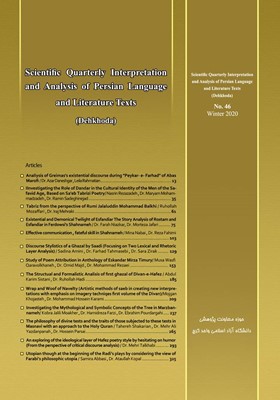Existential and Demonical Twilight of Esfandiar The Story Analysis of Rostam and Esfandiar in Ferdowsi's Shahnameh
Subject Areas : Persian language and literature textsM.R. Keyvanfar 1 , Parvaneh A’del Zadeh 2 * , kamran pashaei fakhri 3
1 - PhD Student, Department of Persian Language and Literature, Tabriz Branch, Islamic Azad University, Tabriz, Iran.
2 - Associate Professor, Department of Persian Language and Literature, Tabriz Branch, Islamic Azad University, Tabriz, Iran.
3 - Professor, Department of Persian Language and Literature, Tabriz Branch, Islamic Azad University, Tabriz, Iran.
Keywords: شاهنامه, رستم, سیمرغ, اسفندیار, گشتاسب, Shahnameh, Rostam, Goshtasb, Simorgh, Esfandiar,
Abstract :
Scholars have ever considered the war between existential and demonical (Ahuraian and Ahrimani) traits and the duality of good and evil of heroes in different stories of Shahnameh. Prominently, this duality is more manifested in the records, words, and deeds of a hero, so he can neither be called an absolute existential (Ahuraian) nor can be considered as a demon, an infernal, and an absolute outcast. Rather, there is a kind of internal conflict in definitions, words, and deeds of a character named Esfandiar. In the current longitudinal research, the researcher has made great efforts using descriptive, analytical, interpretive and library methods to explore whether he is a true Symbols? or is he a demonic symbol? In none of these positions, it cannot be decisively advised. This story, of a prehistoric historical event, was written in a realistic style, where the heroes are unknowingly caught in the misconception of the religion of their time, indicating the father was a prophet. As a result, Rustam's multi-layered demands do not succeed, except for an unintended war. This position continues until the end of the story. Indeed, the existential characteristics of Esfandiar in black-outing his actions and boasting indicate that those deeds are confirmed by Pashtun, Simorgh, Rostam, and Zal throughout the story.
کتاب ها
آرین پور، یحیی (1357) از صبا تا نیما، چاپ پنجم، تهران: نشر سپهر.
اسلامی ندوشن، محمدعلی (1381) ایران و جهان از نگاه شاهنامه چاپ دوم، تهران: انتشارات امیر کبیر.
حمیدیان، سعید (1374) شاهنامه فردوسی، چاپ مسکو، تهران: نشر قطره.
زرینکوب، عبدالحسین (1371) سیری در شعر فارسی، چاپ سوم، تهران: انتشارات علمی.
سرّامی، قدمعلی (1373) از رنگ گل تا رنج خار، چاپ دوم، تهران: انتشارات علمی و فرهنگی.
شمیسا، سیروس (1375) سبک شناسی شعر، چاپ دوم: تهران: انتشارات فردس.
صفا، ذبیحالله، (1371) تاریخ ادبیات در ایران، چاپ دوازدهم، تهران: نشر رامین.
صفا، ذبیحالله (1392) حماسهسرایی در ایران، تهران: انتشاراتی امیرکبیر.
کزازی، میرجلالالدین (1372) رؤیا، حماسه، اسطوره، چاپ ششم، تهران: نشر شابک.
مسکوب، شاهرخ (1389) اصلهای اخلاقی در اوستا (تن پهلوان و روان خردمند)، تهران: انتشارات طرح نو.
ناتل خانلری، پرویز (1373) وزن شعر فارسی، چاپ ششم، تهران: انتشارات توس.
هرمان، اته (2536) تاریخ ادبیات فارسی، ترجمه صادق رضازاده شفق، تهران: بنگاه ترجمه و نشر کتاب.
یاحقی، محمدجعفر (1368) سوگنامه سهراب، تهران: انتشارات توس.
مقالات
بوروس، فردریک اسکینر (1994) بستن رفتارگرایی رادیکال، ویکی پدیا(عدم دسترسی به منبع معتبر تر)
خالقی مطلق، جلال (1337)عناصر درام در برخی از داستان های شاهنامه،از مجموعۀ پژوهشهای تازه تحت عنوان تن پهلوان و روان خردمند، صص 62- 92.
شارل هانری، دو فوشکور/ ترجمه ب. نادر زاده (1371) از مجموعۀ پژوهشهای تازه تحت عنوان تن پهلوان و روان خردمند، صص 10- 16.
کیوانفر، محمد رضا، عادل زاده، پروانه، پاشایی فخری، کامران (1399) تطور تمثیل در داستان رستم و اسفندیار شاهنامه فردوسی، فصلنامۀ تمثیل در ادب فارسی، پیاپی 45، صص 104 – 142.
معصومی، محسن، پور شبلی موسی فرجیهای قزوینی، محمد حسین (1397) نظریه جنگ عادلانه و اخلاق مداری در جنگ میان مسلمانان (بر پایه آداب العرب)، فصلنامۀ تاریخ تمدن اسلامی، سال 4، شماره 27، صص 97 -127.
نورمحمدی نجف آبادی، محمد، باقری، سعید (1392) نظریۀ حنگ عادلانه در فلسفه سنت آگوستین غرب شناسی، دورۀ 4، شمارۀ 2، صص23-50.
_||_
